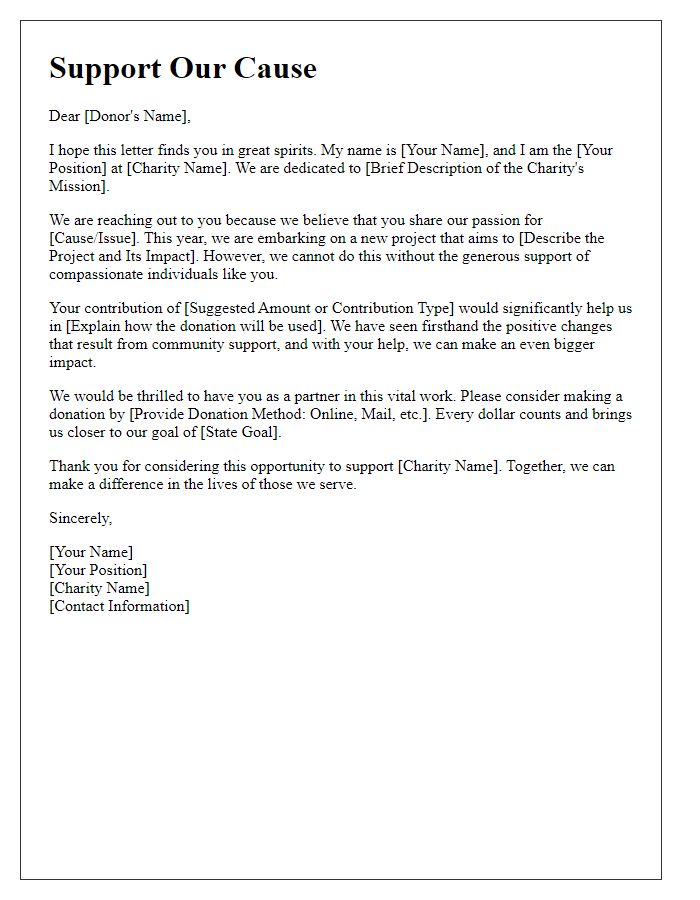When it comes to making a difference, writing a charity advocacy letter can be a powerful tool in your hands. Crafting a heartfelt message not only highlights the cause you care about but also encourages others to join you in support. With the right template, you can clearly articulate your passion and invite readers to take meaningful action. Ready to dive deeper into how to effectively advocate for your chosen charity? Keep reading!

Clear and compelling subject line
Compelling subject lines in charity advocacy letters can greatly influence response rates. A strong subject line should evoke emotion and urgency, encourage action, and clearly state the cause. For instance, "Join Us in the Fight Against Hunger: Your Support Can Save Lives" demonstrates the dire need while inviting immediate engagement. Specific numbers, such as "Help Us Feed 10,000 Families This Holiday Season," highlight the impact donors can make. The inclusion of contrasting phrases, like "Every Dollar Matters" or "Together We Can Change Lives," strengthens a sense of community and shared responsibility. Use of personalization, such as incorporating the recipient's name, can significantly increase the effectiveness of outreach efforts.
Personalization and address
Charity organizations often rely on effective advocacy letters to communicate their mission and garner support. Personalization, including addressing recipients by name, can significantly enhance the impact of these communications. For instance, utilizing specific names such as "Dear Sarah Johnson" engages the reader directly, fostering a connection. Addressing the letter to influential community members, such as mayors or local business leaders, can also amplify outreach efforts. Including a tailored message that acknowledges the recipient's past contributions or involvement with the charity enriches the context. An awareness of local events, like the upcoming "Community Fundraising Gala on December 5th, 2023" in Springfield, can provide relevance and urgency, motivating recipients to take action in support of the cause.
Concise introduction of mission and goals
The mission of our organization, Hope for Tomorrow, is to empower underprivileged communities through education, healthcare, and sustainable development initiatives. Our primary goals include increasing access to quality education for children living in poverty-stricken areas, providing essential medical services to those lacking healthcare resources, and fostering economic growth through skills training and job creation programs. By collaborating with local leaders and leveraging community resources, we aim to create lasting change and uplift lives, ensuring brighter futures for all in need.
Emotional appeal and storytelling
Charity advocacy letters leverage emotional appeal and storytelling to connect with potential donors and inspire action. Personal narratives, such as the transformative journey of individuals impacted by the charity's work, illustrate the organization's mission and impact on communities. Specific examples, such as a child receiving life-saving medical treatment through donations, resonate deeply with readers. Emphasizing statistics, like 85% of beneficiaries experiencing improved living conditions, strengthens the case for support. Highlighting urgent needs, such as a local disaster relief effort for hurricane victims, can motivate prompt contributions. Engaging language creates a heartfelt connection, urging readers to become part of a meaningful solution for those in need.
Specific call to action and contact details
Charity organizations often require clear communication to encourage support and action from their audience. Effective advocacy letters typically include a specific call to action, urging recipients to contribute, volunteer, or participate in fundraising events. Key details such as the charity's mission, recent achievements, and upcoming initiatives provide context. Including contact information, such as an email address or phone number, facilitates easy interaction. Furthermore, outlining the impact of donations on community projects enhances emotional engagement, encouraging recipients to take immediate action in support of the cause.













Comments